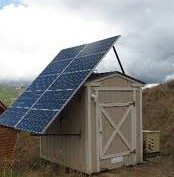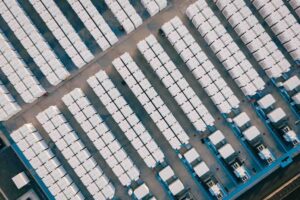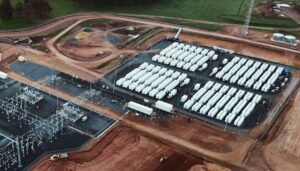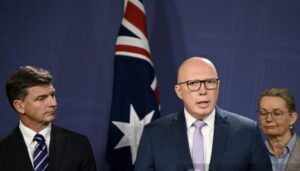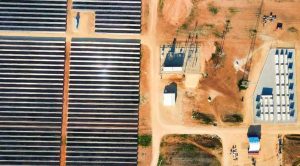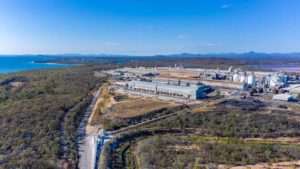(Note: See also Why Ergon wants to keep new solar off the grid) and UBS says Australian households may find it cheaper to off grid by 2018.)
Ergon Energy, which operates the sprawling, regional electricity network that covers 97 per cent of Queensland, has suggested that within the next decade renewables and battery storage will be cheaper for domestic consumers than grid power.
The operator of 160,000kms of power lines, and a million power poles, says it is moving away from the traditional “poles and wires” approach to investment, but it warns that current subsidies to the cost of centralised generation are delaying innovation and investment in new technologies and systems.
 “Will we see a time in the next decade where renewables and battery storage will be cheaper than grid power for the domestic consumer?” Ergon Energy chairman Malcolm Hall-Brown wrote in the company’s annual report. “Queensland’s current uniform tariff may delay some alternatives but innovation is definitely accelerating in the renewable market.”
“Will we see a time in the next decade where renewables and battery storage will be cheaper than grid power for the domestic consumer?” Ergon Energy chairman Malcolm Hall-Brown wrote in the company’s annual report. “Queensland’s current uniform tariff may delay some alternatives but innovation is definitely accelerating in the renewable market.”
The Queensland government spent $600 million in 2012/13 bridging the gap between the cost of delivering coal and gas fired generation to regional centres and what it charges consumers. That taxpayer-funded subsidy equates to $850 per customer a year.
Even with this cap on consumer bills, and the recent removal of the 44c/kWh feed-in-tariff, Ergon Energy CEO Ian McLeod says increasing numbers of householders were looking to solar for certainty and control over costs.
“The network’s role is transitioning from a transporter of electricity to a market enabler, Our customers are increasingly becoming producers selling energy into the grid while changing their consumption behaviours to maximise their return on investment – 14% of households in regional Queensland now have solar,” he says in the report.
The Ergon Energy annual report came out on the same day as that of state-owned generator Stanwell Corp, which blamed the proliferation of rooftop solar for declining wholesale prices and causing it to run at a loss. It also came days after Energex, which looks after the network operations in south-east Queensland, blamed solar for making its economic model unsustainable.
The difference in tone in the reports of Ergon Energy and Energex could not have been more marked. Where Energex – and most other network operators in Australia for that matter, see only doom, Ergon Energy sees opportunity, in the same way as Vector in New Zealand.
“Like Bob Dylan’s immortal classic ‘The Times They Are a-Changin’ so is the purpose of the electricity distribution network,” McLeod writes in the annual report.
McLeod noted that capital investment and technology is now flowing downstream into the customer installations – away from traditional regulated infrastructure to unregulated solutions funded by customers or third parties.
“Alternative energy solutions will set a market-based benchmark in pricing as they become increasingly technically and commercially viable.
 “In this environment the network is no longer a monopoly as it delivers a single commodity that can and is already being supplied via other means. This change means our value proposition needs to shift to enable a strong market for energy, storage and demand management solutions, while still providing a safe, secure and reliable supply.”
“In this environment the network is no longer a monopoly as it delivers a single commodity that can and is already being supplied via other means. This change means our value proposition needs to shift to enable a strong market for energy, storage and demand management solutions, while still providing a safe, secure and reliable supply.”
McLeod recognised that half the cost of electricity in Queensland came from the investment in poles and wires, and the combined impact of higher prices, economic conditions, greater awareness of energy efficiency and the availability of technologies like solar had caused underlying and peak demand to fall significantly over the last three years.
Average household demand from the $12 billion grid that Ergon Energy operates fell 5 per cent in the past year alone, and by 15 per cent over four years, to 6,811kWh per household. Overall demand fell slightly, to 15,097GWh, but again was well below forecasts.
Ergon Energy says it has responded by cutting its spending program by $1.5 billion, has streamlined its workforce and had achieved significant peak demand reductions – and avoided infrastructure investment, through demand management and demand response mechanisms.
 McLeod says Ergon Energy connected another 32,000 solar PV systems to the network, taking its total to 78,000 and the proportion of homes to 14 per cent. It now has 255MW on its network. Added to Energex total of 675MW, the 44MW of solar thermal to be added soon at Kogan Creek and additions in last two and coming months, that will take the state’s total to over 1GW.
McLeod says Ergon Energy connected another 32,000 solar PV systems to the network, taking its total to 78,000 and the proportion of homes to 14 per cent. It now has 255MW on its network. Added to Energex total of 675MW, the 44MW of solar thermal to be added soon at Kogan Creek and additions in last two and coming months, that will take the state’s total to over 1GW.
McLeod says the rate of take-up of solar remains a challenge for the network operator, because “thin grids” are generally more vulnerable to voltage issues. “Historically, the network was not designed for electricity to flow intermittently in both directions,” he sdaid.
Ergon was looking at technical solutions, but he noted the success of Magnetic Island, where the Solar City project had cut demand on the island by 16 per cent and deferred the need for a costly third submarine cable to the island by at least eight years. “The project demonstrated that a comprehensive community engagement program can drive real change to the benefit of customers, electricity utilities and the environment,” he said.
Ergon is also looking at electric Vehicles, which could create similar challenges to solar if sales of EVs suddenly escalated. It noted that a trial of using five Mitsubishi i-MiEVs in Townsville had shown that fuel costs were dramatically lower $4.81 per 100km vs $11.54 for a petrol car), and had given valuable insight on appropriate tariffs to encourage charging at off-peak periods.
McLeod signalled that there was likely to be a change in tariffs, along the lines discussed in these pages, here, here, and here. “We see great opportunity in moving from charging largely based on the amount of electricity used to mechanisms that look at the capacity a customer requires from the network at any given time.”
The options include include mechanisms such as time-of-use tariffs, kVA denominated demand charges and critical peak pricing. Our aim is to spread the electricity load more evenly, manage growth in peak demand and avoid spending millions of dollars in asset augmentation or reinforcement; which would ultimately have been paid for by our customers.”
Despite Ergon Energy’s embrace of solar, new technologies, and new thinking, the annual report also revealed that it had invested little in renewables to meet the national renewable energy target.
It sourced only 7 per cent of its renewable energy obligations (Ergon also operates a retailer) through its own production, and bought renewable energy certificates to meet the remaining obligations. Most of these would have been bought from projects in other states. RenewEconomy has been told that Ergon Energy had been instructed not to invest in large-scale renewables (Queensland does not have any apart from the 20-turbine Windy Hill installation and some bagasse project, but has not been able to confirm that.
There was also surprisingly little renewable energy generation in remote areas not connected to the grid. Ergon used 712,658 gigajoules of diesel generation during the year, and only 671GJ – less than 0.1 per cent – from renewables.
 It says it is looking to increase its renewable capacity to defray the volatile diesel fuel prices and the environmental impacts. Interestingly, it is easier to defray fossil fuel costs in remote locations than on the main grid. A new 264kW solar PV system at Doomadgee (pictured) has been introduced without affecting stability and can be expanded to 2MW.
It says it is looking to increase its renewable capacity to defray the volatile diesel fuel prices and the environmental impacts. Interestingly, it is easier to defray fossil fuel costs in remote locations than on the main grid. A new 264kW solar PV system at Doomadgee (pictured) has been introduced without affecting stability and can be expanded to 2MW.
It is looking at increasing its wind generation on Thursday island, where two turbines supplement diesel, and it is still looking at options to replace its ageing geothermal power station at Birdsville.
While Ergon Energy’s attitude to the grid and new technology opportunities is welcome, and like a beacon in the smog in Australia, it is not entirely clear that it will be able to continue with this vision. The Queensland government has announced it wants to merge Ergon Energy and Energex and bring them under one management. Whether that single management structure reflects backward thinking or forward is not yet clear.
(Note: This story was corrected from first edition to say Windy Hill had 20 turbines, not four).
(Note: See also Why Ergon wants to keep new solar off the grid) and UBS says Australian households may find it cheaper to off grid by 2018.)

